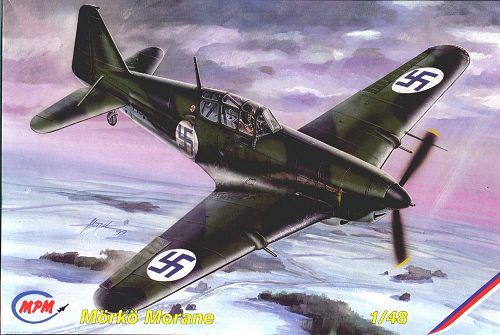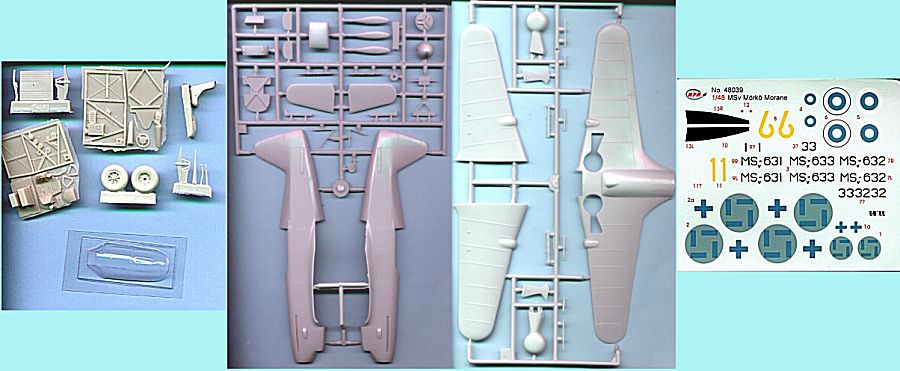
|
KIT: |
MPM 1/48 Morko Morane |
|
KIT # |
|
|
PRICE: |
|
|
DECALS: |
|
|
REVIEW BY: |
|
|
NOTES: |

|
HISTORY |
During the Second World War, the Finnish Air Force seemed to make a specialty of taking aircraft that were "cast offs" from other air forces and "making a silk purse of a sow's ear." The aircraft that comes most readily to mind in this category is the Brewster 239, which was thoroughly castigated by every other air force forced to use it in combat. (It helped that the Finns had the best version, the first one, before weight was piled on without a commensurate increase in power.) Another is the Fokker D.XXI, which was outclassed by all its contemporaries by the time the first prototype made its first flight. The Curtiss Hawk 75 series had a better combat record with the Finns than with any other air force it served with.
Less well-known is the Finnish use of the French Morane M.S. 406. The aircraft were first obtained during The Winter War of 1939-40, though they only arrived in time for a few to be used at the end of that conflict. Following the defeat of France in 1940, the Finns obtained more M.S.406 and M.S.410 aircraft from the Germans. By the time of the Continuation War, the Morane was utilized by an entire Finnish fighter regiment, and several Finnish pilots became aces with this aircraft in combat against the Russians. The Finns were fortunate that - prior to 1942 - the Russian fighters they opposed on the northern front were mostly the I-152, I-153 and I-16, with a few Hurricanes and some early P-40s thrown in for good measure. The Morane in Finnish hands was fighting aircraft of its own generation, so the superior training of Finnish pilots paid off in combat success. The arrival of Yaks, Lavochkins and P-39s, beginning in the summer of 1942, changed that.
The airplane was seen as obsolete by any standard by 1942, and would have been discarded had there been an airplane that could replace it. As an alternative, a plan was developed to use the Klimov M-105P - an engine developed from the Hispano-Suiza 12Y series that powered the M.S.406 - to re-engine the Moranes. The Germans had captured large numbers of these engines and the associated VISh-61P propeller, which they were willing to sell to the Finns. The prototype conversion was flown in February 1943 as the Morko (Ghost) Morane. Flight test revealed the concept was sound, with an acceptable increase in performance all around, while maintaining the maneuverability of the original design. Only two were converted before the end of the Continuation War in September 1944, and only one victory was recorded. 41 further aircraft were converted after the war, and the type remained in Finnish service until September 1948.
|
THE KIT |

The kit arrives in the box on two sprues of light-grey plastic with little flash, a bag of resin parts for the cockpit and a decal sheet for two aircraft, one in Continuation War markings and one in post-war markings.
It is well-known that MPM is the primary contractor for Classic Airframes, with Eduard a close second. If you have the Classic Airframes M.S.406 in your collection, this new kit from MPM will look familiar. It is the Classic Airframes kit from the firewall aft.
Vincent from Adeco has provided an excellent critique of this kit in the HyperScale Discusion Group, and I recommend any modeler contemplating building this model consult that posting. With the change in the nose contours, it is my belief that a modeler can get around most of the problems associated with the kit and create an acceptable recreation of this airplane. I would sand the centerline of the rear fuselage into a concave curve to remove about 1/16" in width aft of the cockpit, as well as sand down the leading edge of the rudder to narrow it. The wing blisters for the machine guns should be re-shaped. The cockpit as provided is not accurate, and a modeler who wants some accuracy should consider purchasing the True Details resin cockpit for the M.S.406, which is far more accurate. I also understand Adeco is creating some resin correction parts for the kit, and this will be useful here as well as with the original release.
|
CONCLUSIONS |
An interesting model of a rare version of an historically-significant airplane, one I never thought would grace my model shelves without my doing a conversion.